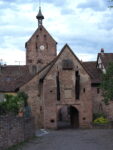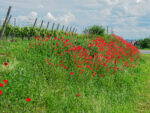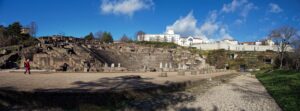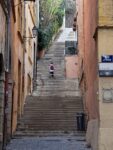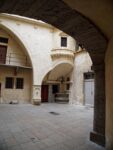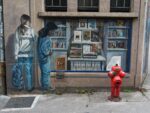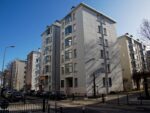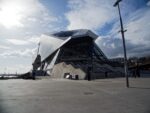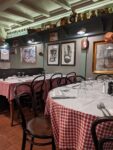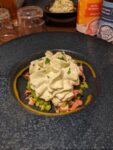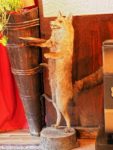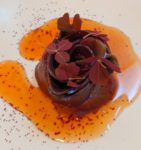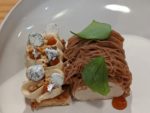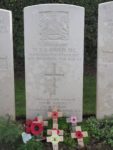To download a printable PDF version (no photographs)
click on this link E2E2024no1.pdf (six A4 pages)
There are links to photographs in the text and
clicking on the photographs in the text will show a larger version
There are no asparagus fields around Entre-deux-Eaux. Our local fields are mainly used by cows, as pasture or for winter fodder, with occasional maize or winter wheat crops. But at this time of year, in April and May, villagers’ thoughts turn east to Alsace and its asparagus. Nearly every local restaurant, small or large, will offer asparagus as a starter and often also as part other courses as well, In the nearby small town of Provenchères-sur-Fave, the Mother’s Day (26 May here) special Sunday menu in a restaurant had asparagus as its starter. People also drive over the Vosges to buy asparagus directly from the growers. Earlier in May, a party of villagers from Entre-deux-Eaux oldies club went over the hills for an asparagus lunch and dance for 350 people, though one complained that she was still hungry when she got home.
During the long wet winter months, we have enjoyed going out for a restaurant lunch roughly once a week. It is always good to try new restaurants as well as old favourites, and if they are nearby in Saint Dié so much the better. At the end of April, when it was still miserable weather, we tried the recently opened Le 29 on the main street (no. 29) of Saint Dié. It was good to get off the cold, windy street into a small but busy little restaurant of eight tables, which looked larger with its murals of sunlit woods. There was a warm welcome from the bustling young madame, Marilyn, and through glass doors into the bright kitchen at the rear we could see chef Cedric and his assistant busy cooking and decorating dishes. Not surprisingly, one of their starters that week was listed as Les asperges blanches d’Alsace (ferme Clarisse, Sigolsheim), emulsion savoyarde et croustillant pancetta which also featured an egg cooked at a low temperature. Helen decided to sample the frogs’ legs, which she didn’t remember having tasted before, but John chose the asparagus and said the savoyarde emulsion, a cheesy sauce, added a good flavour to the asparagus.
In the past we had bought asparagus at Sigolsheim from Clarisse’s small hut-like shop up a narrow side street. Now there is a larger, up-market shop attached to a restaurant on the main road through Sigolsheim. Ghislaine (who visits us to practice her English) and her husband went for a meal there this year, but they were really disappointed, finding it very expensive for the asparagus soup and asparagus-and-ham main course. They were also annoyed that Clarisse’s strawberries were on the dessert menu but not available to eat, although there were plenty in the attached shop, but the restaurant staff refused to prepare them.
When we were at L’Imprimerie in the book village in April, they served their asparagus with a hollandaise sauce. The cheese course is, alas, rarely part of set menus in French restaurants these days. But with the Imprimerie’s curtailed menu (see below) we missed the previous leisurely succession of filling dishes, so when Damien wheeled up the optional cheese trolley, we decided to indulge. The smoked goats’ cheese was our favourite, with a good pumpkin chutney.
In January we had discovered their main chef, Morgan, had been head-hunted and had moved on to a larger, more prestigious restaurant in a spa hotel in the woods above lac de Longemer and taking two of the younger restaurant chefs as well. His co-owner chef, together with a new assistant chef and the grumpy waiter are carrying on at the Imprimerie, but have reduced the number of opening days and have been serving a less ambitious weekday set lunch to fewer tables.
Like true groupies we decided the following week to follow Morgan to his new restaurant, Les Jardins de Sophie, for lunch. It was delicious, and he’d obviously carried over his own style as two of the dishes were similar to those we’d eaten at his old restaurant! But the cheese selection was less interesting – and there was no pumpkin chutney to add flavour. At the end Morgan showed us his big new kitchen with great pride, as he now has fifteen staff working under him including a pastry chef.
Another restaurant which we tried for the first time, Le Bistro d’ Azerailles, was distinctly down market from Les Jardins de Sophie and served neither asparagus or cheese, but a varied hot and cold buffet. Arriving at 12.20, we walked into an unpromising, dingy fifties style bar in an old station hotel in the small town of Azerailles; there was only one diner or drinker, and no sign of staff. Eventually the chef came to the bar, smiled, and led us round the end of the bar, through a narrow room and into a busy, large restaurant, where he handed us over to Madame. We should probably have noticed and come in through the other door that opened directly into the restaurant! Before we were let loose on the buffet, we were asked if we’d like aperitifs – no thanks. Wine with the meal? Yes please! So chef led us proudly to their latest project – a well-lit wine cellar with tables and chairs and expensive bottles in racks on the walls. Realising our mistake, we said it was a really splendid display, but we only wanted a glass each, so were led back up to order from the bar. The starters were really good, so we went back for more. We realised we should have got there a bit earlier, to get the full selection of the mains, and we were lucky to get the last of the desserts. Other diners had left and the staff had disappeared when, after coffee, we were ready to pay. It’s somewhere we’d go back to, – but promptly at mid-day.
The Bistro d’ Azerailles’ vegetables of the day were peas and potatoes. John had been rather surprised when we were at the Amnesty Book Sale in Saint Dié in February and he picked up a book of the best recipes from season 4 of the French Masterchef TV series, to find it contained a technical tip for cooking vegetables a l’anglaise with photos of the four stages: boiling a lot of salted water, tipping in the vegetables, pricking them with the point of a knife to see if they are well cooked, lifting them out into ice-cold water. Is that considered by French Masterchef to be the height of English gastronomy? An indication that we have some interests above and beyond our stomachs and restaurants (though it might not otherwise be obvious from this newsletter), is that we also bought an Italian design book, some Michelin green guides to parts of France we haven’t yet visited, and Helen found a well illustrated 1932 children’s science fiction book.
The previous February weekend, Helen went with the Sainte Marguerite club on the annual theatre trip to the Alsace village which gives an amateur theatre production preceded by lunch. The lunch is always well organised, but this year there were negative comments that they’d cut down on wine and there was no cheese course. But the new play, La Candidate, a farce about a presidential election was as amusing as ever.
Later that week it was Helen’s turn to lead the Friday Remue Meninges, or brain exercise, group. This time she’d found a couple of good French sites to plunder. So the group started with arranging a seating plan for a family dinner party for 10, taking into account all the antipathies and requirements of participants, so a logic problem with only one solution possible. There’s always someone in the group who says they don’t know what to do, without having read the information and worked out the logic! Next there were three exercises of anagrams, the last being Tintin titles (given how big cartoon strip/graphic novels are here, it was surprising that not everyone had read Tintin to their children or grandchildren). Pandering to the popularity of the British Royal Family here, the next exercise involved applying the information given about the strict rules of succession, to find out who would have succeeded at particular dates had the queen died then (“I don’t know what I’ve got to do”, wailed the same person without reading the info). With a word-search for capital cities (French spelling) which absorbed everyone, the room went quiet for the first time as they really concentrated. Finally a crossword. After which someone boiled the kettle for hot drinks as the room is inadequately heated and Helen produced the cinnamon buns that John had made that morning, and everyone relaxed and gossiped.
In March and early April we enjoyed seeing family and friends around Easter time in Letchworth. So lots of cooking for John, egg hunts for children, and gardening and trips on the rare days when the weather was fine.
On our return to Entre-deux-Eaux, we faced the same problem of finding a time for gardening when it was not raining. Fortunately the day Dusty chose for rotavating our vegetable patch was sunny after a heavy overnight frost (and snow on the hills the previous day). Helen has been busy on other fine days slowly raking over the beds and sowing the usual carrots, parsnips, beetroot, lettuce and leeks outside. The broad beans, peas, courgettes, pumpkins and squash which were sown inside are now being planted out. Will they all be washed away by all the subsequent rain? In May Saint Dié had a Jardin dans ma ville event with plant stalls up both sides of the main street (which was closed to traffic). We walked round the stalls and selected a few herbs to replace those that do not seem to have survived the winter.
As for the cold eggs, many of you will have been following John’s videos of the kestrels nesting on our attic windowsill on the website 2024 – Kestrels in Entre-deux-Eaux, wincing at two females fighting (rather disturbing) in March and rejoicing at the laying of six eggs in April. You will have no doubt grieved when the male disappeared on 25 April, leaving the female without any food on her seventh day of brooding on the eggs. We assume the eggs would have got too cold to be viable after she was forced to leave them for long periods to hunt for food (and possibly her mate).
However a younger male then started visiting the windowsill and bringing voles, mice and lizards for the female, and on 7 May the female laid the first of a second batch of eggs. By 15 May eleven eggs could be seen, with old and new all together. Unfortunately the sill overlooks the vegetable garden, and the female deserts the eleven eggs whenever one of us goes into the garden, as well as when cyclists and dog walkers pass. As the honeyberries in the fruit cage are now ripe and the strawberries soon will be, there will be additional disruptions for her from our gardening stints. But if all is well, perhaps some of the five new eggs should hatch around 9 June. In discussions with two in France and Czechia who have had kestrel nests for many years, this many eggs is unknown and difficult for the female to cover. After the additional seventh egg was laid in the second clutch, the opinion was there would only be another two at most. Perhaps this might become an entry in a record book? So watch the website!
At the beginning of May we went to an exhibition at the museum in Saint Dié on the striking architecture of L’ilot utopique de Raon l’Etape. A hotelier in Raon l’Etape had enterprisingly commissioned the building in 1966-7 of an annexe to his hotel on a little island in the river Meurthe, comprising motel rooms designed by Pascal Häusermann et Claude Häusermann-Costy. The nine concrete spheres could accommodate 24 guests in total. Apparently the large printing firm that Ghislaine’s husband worked for would accommodate business visitors there, as it was a bit different with its esprit soixante-huitard. It was called Motel l’Eau Vive, then later l’Utopie. It had various owners and was classed as a historic monument in 2014. We had been very taken with the unusual balloon shapes when we visited and had drinks there after a couple of young Swiss enthusiasts had taken it on. But it has been closed for some years. It is being renovated and is due to reopen as a hotel later this year. The exhibition had more information about other projects of the architects, including a video of the time-consuming construction and growth of a private home (no possibility of hanging paintings of constructing bookshelves on those curved igloo-like concrete walls!)
The local villages hold an annual art event in May, with exhibitions in different village halls. The first year we went, our American friend Nicola won a prize for her paintings, and we were proud to still see her name at the top of the list of winners (if mis-spelt). But alas the quality of paintings has deteriorated in recent years. However, the photographs exhibited at the former seminary in Saulcy were more interesting, and we were pleased to be invited to the vernissage, or drinks reception the evening before, as Paul, the recently arrived resident of E2E, was showing more of his photographs.
May is a month of public holidays here, a month of holes like cheeses, as Ghislaine observed during our linguistic exchanges. The month opens with Workers Day, the following week there is Victory Day and Ascension Day, and two weeks later Pentecost. So it was hardly surprising that none of Helen’s birthday cards were delivered until two days after the event (pathetic sniff). Nevertheless her birthday was a festive as well as obligingly sunny day as we drove over to Riquewihr, a small mediaeval walled town in Alsace which had not been destroyed in WWII as the road to it didn’t go any further. We had lunch just outside the walls at the foot of the vineyards, on the terrace of a restaurant with the unwieldy name of AOR La Table, le gout et nous. The amuse-bouche was, of course an asparagus soup, though this one was accompanied by lavash (a crisp, spicy Armenian bread). The fish course of bream was also accompanied by asparagus, but the star was the veal, sweetbread, risotto, with zucchini and apple wrapped in a green bean. What drew the attention of neighbouring tables, was our Moni-k-Bill dessert of a smoking chocolate cigar and mango cream, as we were the only table presented with it. In fact, it was less of a surprise to us as, on our previous visit, we had also had chef’s signature dish, which harks back to the Lewinsky/Clinton affair.
We had decided to stay overnight Sunday at the hotel next door to it, so we did no have to worry about our wine consumption, and it was pleasant strolling round the old streets of Riquewihr in the cool of the evening when the crowds of tourists had left. We had first visited Riquewihr in the ‘eighties on a winter evening with a spectacular sunset over the vineyards, and equally quiet streets, and we had fallen in love with it, so it was good to see it again restored to tranquillity at the end of the day. Next morning we went out to get coffee and croissants from a bakery. We sat on the rim of an old well eating them and watching a tanker emptying a street drain, deliveries to cellars and walkers setting out with haversacks and maps.
On the way home we stopped in the next village at a small wine producer to buy some bottles of the Gewurtztraminer wine that Helen had really liked at lunchtime. We were lucky in our timing, as the husband and wife were just pulling out on their gateway with a trailer of garden prunings for the tip, but stopped immediately they saw us and opened up. There can’t be much call for wine on a Monday morning. It feels a long time since we bought from a grower, and we reminisced about buying our first Gewurtz from another small producer on that first visit nearly forty years ago.
Two days later we rounded off Helen’s birthday with a splendid lunch at Enfin restaurant, again amid the vineyards of Alsace, but a bit further north in Barr. Their Hommage au Printemps sequence of small dishes featured plenty of herbs from the beds outside their windows and also fish from the river Rhine. After a succession of tasty herby mises en bouche, we had the inevitable but beautifully presented asparagus, both white and green with lovage, cream and asparagus ice-cream cornets. Perhaps the most memorable dish was the Rhine carp in a potato crust, with sorrel and wild garlic sauce. The dessert trolley at the end was heavily laden, and being Alsace there were lashings of cream on everything. But asparagus ice cream as a dessert must be an acquired taste.
We drove back along a steep, winding forest road rather than through the vineyards, enjoying the scenery.
But no, that was not in fact the last celebration, so hold on for a bit more food description! This week the monthly E2E club for the oldies (more properly called La vie du bon côté) toasted all the May birthdays in either crémant or cider. The onus of cake-making has been taken on by Stephane, the enterprising village caterer who makes very good cakes, so Helen joined other May birthdays villagers in blowing out candles on his creamy Paris-Brest (whose wheel shape is said to be a tribute to the Paris-Brest cycle race), luscious rhubarb tart or generous cream-and-raspberry sponge cake, as the card and game players sang Joyeux anniversaire.
On the walk home, Helen admired the colourful azaleas and peonies in the sheltered garden of the oldest village house, queried the presence of two gendarmes outside the unfinished, deserted house of our former builder, stopped to check if our neighbour still wants some felled tree branches from the bottom of our orchard, and finally caused the female kestrel to temporarily fly in alarm from her eggs. After the cakes, candles and champagne, everyday life in Entre-deux-Eaux resumed.



